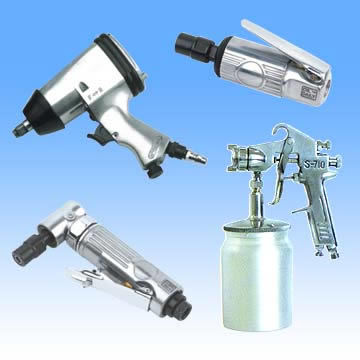AIR SUPPLYTools in the range generally operate at a maximum pressure of 90 psi you should consult manufacture specifications for correct working pressures also it would be advisable to controlled air consumption with combined regulator/oil/water separator unit which with proper maintenance will ensure a constant supply of dry air and lubricating oil at all times. Always check machine operating pressure before use. Water in the compressor tank will cause serious corrosion to your air tools and should be drained daily to avoid excessive water in your air supply. Dirty wet air rapidly shortens the life of your air tool. If you are using an air tool on a hose over 25ft. long it is advisable to increase the bore of the hose to the next larger size available ie. 1/4" increases 3/8". This will ensure adequate pressure and volume of air to power the machine.

RECOMMENDED AIR SUPPLY OPERATION:
Some air tools have inbuilt regulators which can be used to control speed/torque performance, on machines without inbuilt regulators this can be done by varying the pressure on your air supply regulator.
MAINTENANCE:
Every day, before use, remove the tool from the air line, use an oil can and pour the equivalent of a tablespoon of suitable oil into the machine (through the air intake). Operate at low speed to ensure lubrication of all moving parts. If machine is in constant use or is to be used for long periods of time a combination filter/lubricator must be fitted in the system. At all times the system must be fitted with an air filter.
Recommended Air Tool oils
Tellus 22
Duckhams
Zircon 32
Castrol AWS32
Do not use normal engine oil or similar.
Please note:
Failure to care for your 'air Tools' and not caring out general Maintenance will not only lower the life of your air tool but also will invalidate any manufacture Guarantee.
TROUBLE SHOOTING SAFETY RULES FOR AIR TOOL PRODUCTS
1. Always wear safety goggles or glasses.
2. Always ensure machine is switched off before connecting to air supply.
3. Disconnect any machine from the air supply before changing blades or discs, and before servicing any type of machine.
4. Always keep your air tool clean and lubricated. Daily lubrication is essential to avoid internal corrosion and possible failure.
5. Do not wear watches, rings bracelets or loose clothing when using air tools.
6. Using only light weight coil hoses from a tool to the wall or compressor coupling. Do not fit quick change couplings onto the machine as vibration can cause the coupling to fail.
7. Do not overload the machine. Allow the tool to operate at its optimum speed for maximum efficiency. 8. Do not increase the air pressure above the manufacturers recommended level, as excessive overload can cause the machine casing to split. Also this creates excessive wear on moving parts and possible failure.
9. In the interests of safety and possible damage to the machine/operator, always ensure that the machine has stopped before putting it down after use.
10. Always ensure that the work piece is firmly secured leaving both hands free to control the machine. 11. Always ensure that the accessories such as blades, discs, sockets, etc. are rated/designed for use with the machine. Also correctly and securely fastened before connecting the machine to the air supply.
PROBLEMS POSSIBLE CAUSES REMEDIES
Symptom: Tool runs at normal speed but loses under load Motor parts worn. Possible Cause: Cam clutch worn or sticking due to lack of lubricant.
Solution: Lubricate clutch housing. Check for excess clutch oil. Clutch cases need only be half full. Overfilling can cause drag on high speed clutch parts, ie. a typical oiled/lubricated wrench requires 1/2 ounce of oil.
GREASE LUBRICATED: NOTE:
Heat usually indicates insufficient grease in chamber. Severe operating conditions may require more frequent lubrication.
Tool runs slowly.
Air flows slightly from exhaust Motor parts jammed with dirt particles Power regulator in closed position Air flow blocked by dirt.
Check air inlet filter for blockage.
Pour air tool lubricating oil into air inlet as per instructions. Operate tool in short bursts quickly reversing rotation back and forth where applicable. Repeat above as needed. If this fails return to manufacture service centre. Tools will not run. Air flows freely from exhaust
One or more motor vanes stuck due to material build up.
Pour air tool lubricating oil into air inlet.
Operate tool in short bursts of forward and/or reverse rotation where applicable. Tap motor housing gently with plastic mallet. Disconnect supply. Free motor by rotating drive shank manually where applicable If tool remains jammed return to service centre. Tool will not shut off ‘O’ rings throttle valve dislodged from seat inlet valve. Replace ‘O’ ring or return to service centre. Note: Repairs should be carried out by a qualified person.



No comments:
Post a Comment